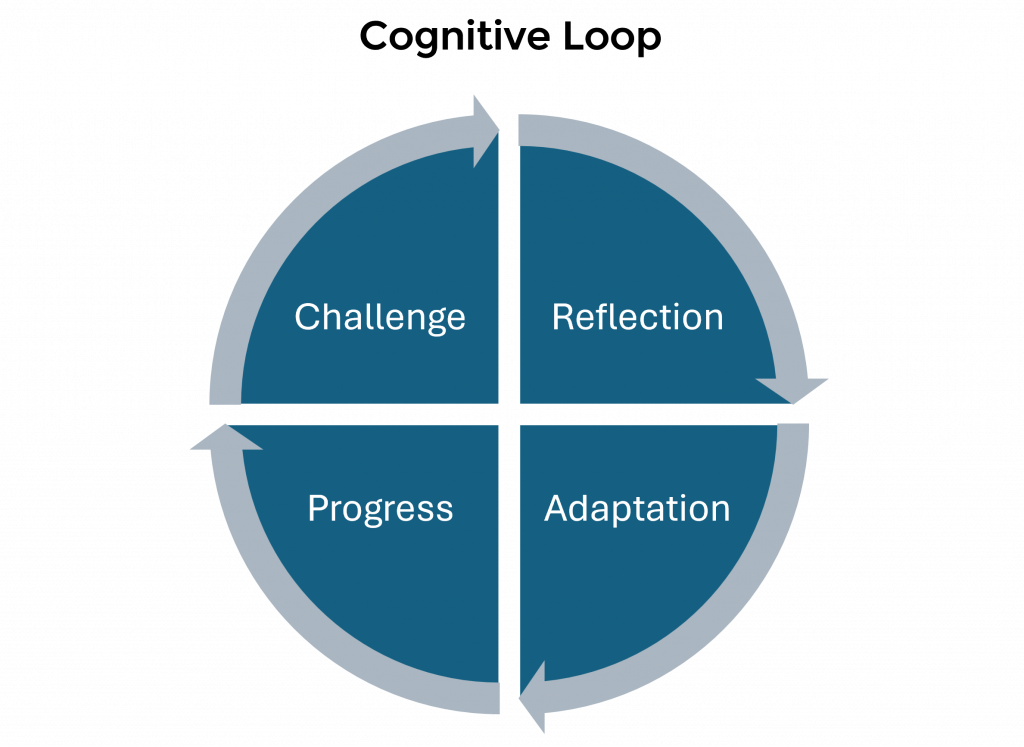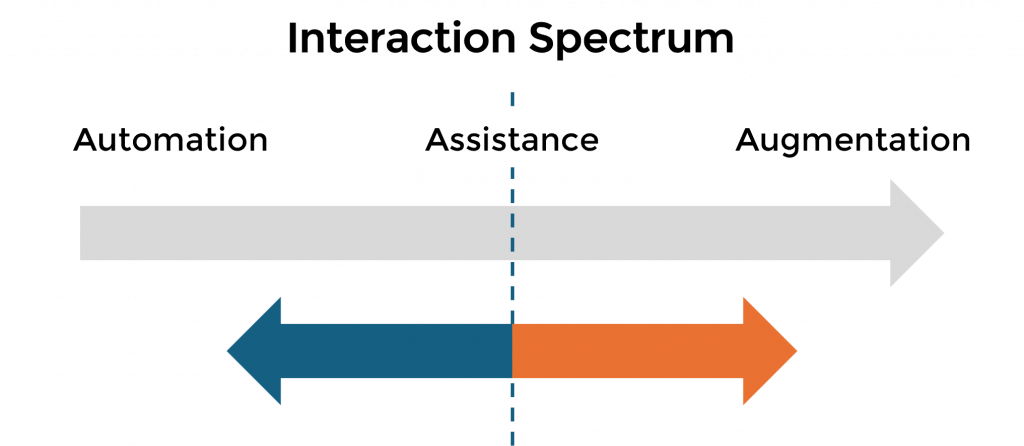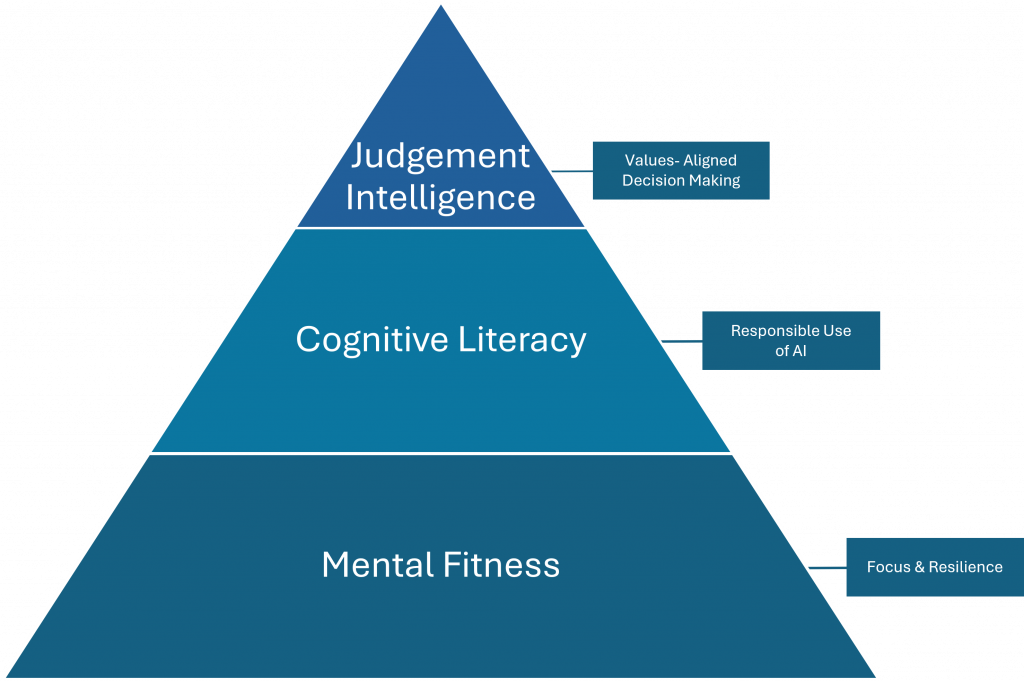Introduction: From Efficiency to Intelligence
The next decade will not belong to the most efficient organizations, but to those that combine efficiency with the capacity to think, adapt, and learn.
For years, leaders have worked to remove friction from their systems. They streamlined processes, automated complexity, and built cultures that reward speed and precision. Artificial intelligence now extends that pursuit to the mind itself, promising to think, write, and decide faster than humans ever could. Yet, when progress eliminates all effort, it can also eliminate growth.
“Efficiency without reflection builds speed, not strength.”
The organizations that will thrive in the coming era are those that combine efficiency with adaptability. They cultivate adaptive intelligence, the capacity to learn faster than the environment changes. Achieving that balance calls for a new kind of leadership, one that views human cognition not as an expense to be managed but as an advantage to be strengthened and integrated with technology.
This is the essence of a cognitive strategy for leadership. It means designing organizations where people and machines complement each other, each amplifying the other’s strengths. It means preserving the challenges that build wisdom while embracing the tools that expand reach. And it begins with understanding how intelligence, both human and organizational, continues to grow.
The Economics of Thinking
The human brain is optimized for efficiency. It automates the familiar, builds habits, and conserves mental energy. Those traits help individuals operate effectively but can quietly undermine organizations that rely too heavily on comfort and repetition.
In a knowledge economy, thinking itself has become a form of capital. Attention, reasoning, and creativity now carry tangible value. Each time a company transfers cognitive effort to technology, it makes a trade: gaining speed but risking depth. Over time, organizations that automate too much of their thinking lose the slow, deliberate reasoning that builds understanding.
“Thinking is the new capital. Attention is its currency.”
Wise leaders are starting to manage cognition as intentionally as they manage cash flow. They protect focus, create space for thought, and invest in reflection. They see curiosity and attention as renewable resources, and they design systems that sustain them.
When leaders treat thinking as capital, they recognize that efficiency is not the enemy of depth, it is the result of it.
How the Brain Builds Intelligence
Human intelligence develops through challenge and reflection. The prefrontal cortex, which handles reasoning and planning, strengthens through use. The hippocampus connects new information to existing knowledge, anchoring it in memory. Together, these systems thrive on struggle.
Neuroscientists call this process plasticity, the brain’s ability to adapt through experience. Plasticity depends on effort. When people engage deeply with complex tasks, their brains literally rewire to accommodate new knowledge.

Organizations function in much the same way. Teams that face challenges together, debating ideas, testing assumptions, and reflecting on outcomes, build collective understanding. They evolve shared language and instinct. That dynamic is organizational plasticity, the culture’s ability to reconfigure itself in response to learning.
When leaders remove all difficulty, that adaptive capacity weakens. True intelligence, whether individual or organizational, grows in the space between comfort and challenge.
AI as a Partner in Human Learning
Artificial intelligence expands human potential when it invites interaction rather than passive use. AI can analyze data, simulate outcomes, and generate ideas, but the value lies in how people engage with it.
Neuroscience shows that interaction drives learning. When people question, adjust, or critique an AI’s output, their brains remain active in meaning-making. This engagement strengthens memory and critical thinking. Passive consumption does the opposite: it quiets neural circuits related to reasoning and problem-solving.
“Interaction is intelligence in motion.”
The Brain Rot discussion highlighted how overreliance on AI mirrors the effects of cognitive atrophy. When people delegate all thinking to machines, dopamine cycles that normally reinforce curiosity and accomplishment decline. The hippocampus, responsible for memory and spatial reasoning, becomes under-stimulated. The result is a brain that grows more efficient but less capable.
AI should therefore be framed as a thinking partner, a collaborator that challenges assumptions rather than replacing them. Teams that interact dynamically with AI will expand their cognitive range, while those that defer to it risk losing depth.
Organizations can operationalize this idea by embedding “human-in-the-loop” practices: requiring employees to interpret, validate, or refine AI recommendations before implementation. The act of evaluation sustains learning. The reward is not just better decisions but smarter people.
The Cultural Layer: What AI Says About You
Technology does not merely perform tasks; it communicates values. How an organization uses AI tells a story about what it believes and prioritizes.
A chatbot that favors efficiency over empathy signals a company’s orientation toward convenience rather than care. A hiring algorithm that rewards conformity over diversity reflects a narrow definition of success. Internal systems that automate judgment suggest a culture that values compliance more than curiosity.
As described in The Silent Signals of Organizations, systems are never neutral. Every design decision transmits silent cues about trust, autonomy, and worth. Employees read those cues intuitively. So do customers.
“How you use AI is how your organization speaks.”
AI now amplifies these signals. It has become part of an organization’s behavioral communication system, shaping how people experience its character. When AI is implemented transparently, with clear ethical standards and thoughtful oversight, it communicates confidence and respect. When it replaces dialogue or hides decisions, it communicates distance.
Leaders should therefore view AI as both a technological and cultural design choice. Each deployment reflects what the organization stands for. How you use AI is, in many ways, how your organization speaks.
The Two-Way Mirror: Interaction Over Delegation
Every interaction with technology either builds or erodes cognitive strength. When we engage critically, our brains release dopamine that reinforces curiosity and motivation. When we simply accept results, that cycle stops.
Studies on cognitive engagement show that active participation keeps the hippocampus and prefrontal cortex synchronized, essential for learning, creativity, and self-regulation. Passive interaction disrupts this alignment, leading to shorter attention spans and weaker memory consolidation.
For leaders, the takeaway is clear: encourage teams to interact with AI, not just use it. Ask them to critique, compare, and interpret outputs. Build workflows that require reflection rather than blind trust.

This not only preserves cognitive health but also strengthens collaboration. Teams that engage with technology together discuss, debate, and learn. Those that delegate thinking to the system lose the shared reasoning that drives collective intelligence.
The long-term risk is synthetic cognitive atrophy, a gradual erosion of human capability as organizations grow dependent on automation. Interaction is the antidote.
Designing for Cognitive Culture
If AI reveals what a company values, then the way people interact with it defines the organization’s cognitive culture, the norms and habits that determine how thinking happens.
Designing a healthy cognitive culture begins with curiosity. Leaders can model inquiry by asking open questions, inviting challenge, and celebrating thoughtful dissent. These behaviors make thinking safe again.
Training also matters. Teaching employees to use AI responsibly, to analyze bias, verify sources, and test alternatives, develops what might be called cognitive literacy. This skillset ensures that people understand both the power and limitations of the tools they use.
“A culture that values thought will never fear automation.”
Recognition systems should evolve as well. Instead of rewarding speed alone, reward insight. Celebrate the teams that find meaning in complexity, that use data to generate understanding rather than noise.
When culture reinforces engagement, reflection, and humility, technology becomes an accelerator of wisdom instead of a substitute for it.
Organizational Neuroplasticity: How Cultures Learn
When a culture encourages interaction, reflection, and thoughtful use of technology, it develops its own form of neuroplasticity. It learns. It rewires itself.
Just as the human brain adapts to new experiences, an adaptive organization continuously reshapes its structures and norms in response to feedback. Leaders can support this by fostering an environment that balances challenge with safety, enough tension to stimulate innovation but enough trust to prevent fear.
The most adaptive companies treat friction as feedback. They learn from mistakes, refine their systems, and evolve their mental models faster than the market shifts around them.
Organizational neuroplasticity is not about technology alone. It is about how humans and systems learn together.
The Cognitive Organization
Organizations that master this integration, of cognition, culture, and technology, become cognitive organizations. They are deliberate about how they think, learn, and communicate through their systems.
They measure cognitive health as carefully as financial performance. They design structures that promote deep work, reflective dialogue, and curiosity-driven problem-solving. AI serves as a catalyst, helping humans discover new connections rather than automate existing ones.
In these environments, people feel energized by challenge. Teams see reflection not as delay but as progress. The organization itself behaves like a living, learning system, resilient, adaptive, and self-aware.
A New Equation for Progress
-
The Industrial Age rewarded speed. Output = Efficiency × Scale.
-
The Cognitive Age rewards wisdom. Progress = Intelligence × Reflection.
AI brings intelligence. Leadership brings reflection. Together they create the kind of wisdom that cannot be automated.
The Future of Leadership
The next generation of leaders will be judged not only by what they achieve but by how intelligently their organizations think. They will treat learning as infrastructure, attention as capital, and curiosity as culture.
Leadership will require a balance of mental fitness, cognitive literacy, and judgment intelligence. Mental fitness sustains focus under pressure. Cognitive literacy enables thoughtful use of technology. Judgment intelligence guides decision-making that aligns data with values.
“The next era of advantage belongs to those who think deeply and learn fast.”

These leaders will design ecosystems that protect deep thought, reward meaningful dialogue, and invite collaboration between humans and machines. Their organizations will not fear automation because they will have built what cannot be replaced, the capacity to keep learning.
Reflection Questions for Leaders
-
Where has efficiency outpaced learning in your organization?
-
What cultural signals do your AI systems send to employees and customers?
-
Are your teams engaging with technology or deferring to it?
-
How do you measure cognitive health and adaptability?
-
What would a culture of curiosity look like in practice?
-
How are you developing mental fitness and judgment across leadership ranks?
-
If your organization’s systems could speak, what would they say about your values?
Related article: Struggle as Strategy: How Leaders Can Balance AI and Human Growth
